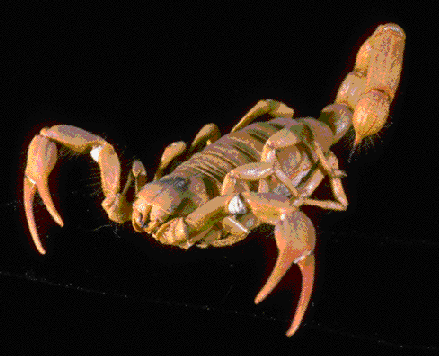Scorpiones


Scorpions are the oldest arachnids for which fossils are known, and they were the first arachnid fossils to be found in Paleozoic strata. The Silurian scorpions appear to have lived in the water, since their fossils have gills, but by the Carboniferous scorpions with such features are no longer found -- fossils from the Pennsylvanian age Mazon Creek beds have book lungs covered by protective plates, and so were probably land-dwellers. The best scorpion fossils come from the Devonian and the Oligocene; there is a severe lack of fossils known from the intervening period.
These earliest scorpiones are considered to be Protoscorpions, since they possess many traits which are plesiomorphic for scorpions. For example, in all scorpions the thick front portion on the abdomen is made up of seven segments, but the number of sternite plates which cover this region varies among the earliest fossils, while all living species have five. All scorpions have an additional five segments after the initial seven, ending in a sharp sting. This sting contains a pair of poison glands which can paralyze prey, usually insects or small rodents, or may deliver a painful sting to incautious persons. Most scorpion stings are merely painful, leading to swelling in the immediate region of the sting, but some scorpions of northern Africa and the American southwest can be deadly. In the US, the deadliest scorpions are to be found in Arizona, where it is a good idea to shake out shoes before putting them on in the morning!
Besides their unusually long and dangerous tails, scorpions also differ from other arachnids in having large pedipalps. These are the second pair of appendages on the body, and are usually rather inconspicuous in arachnids, but in scorpions, they are large and powerful pincers which may be used to grasp and subdue prey. Scorpions may also have more eyes than other arachnids, some species possessing as many as six pairs, though most do not have this many. They have three joints in their chelicerae, or the first pair of appendages, located next to the mouth.
Most scorpions are nocturnal, hiding under rocks, in crevices, or within burrows during the day, and coming out after sunset. Because of this, and because of their painful stings, it can be dangerous to travel at night in scorpion territory without shoes, even inside homes. (I have nearly stepped on a scorpion in my parents' home near Dallas.) One unusual feature of scorpions that has helped many field biologists is the UV fluorescence of scorpion bodies. Biologists hunting for scorpions wave an ultraviolet light near the ground as they walk along, watching for an eerie greenish light to be reflected back. The UV light is absorbed by the scorpion's armor and is reflected back as visible light.
For more on the classification and phylogeny of scorpions, visit the Scorpionida pages at the Tree of Life.
Scorpion photographs are available from the Scorpion du jour page by Dr. Scott A. Stockwell.


